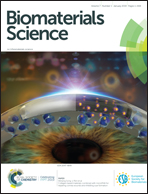Polymer–antibiotic conjugates as antibacterial additives in dental resins†
Abstract
Affecting the vast majority of human beings, dental caries is a premier concern of worldwide dental health. As the most commonly used restorative material to treat dental caries, resin-based composites (RBCs) lack antibacterial properties leading to quite limited restoration lifetimes. The objective of this study is to develop a polymer–antibiotic conjugate (PAC) as an effective antibacterial additive for RBCs. A monomer–antibiotic conjugate (MAC) with significant solubility was prepared by an esterification reaction of tert-butyloxycarbonyl (Boc)-protected ciprofloxacin (Cip) and 2-hydroxyethyl methacrylate (HEMA). The Cip-containing PAC with well-controlled molecular weight and composition was synthesized by reversible addition–fragmentation chain transfer (RAFT) copolymerization of the MAC with HEMA (1 : 3 molar ratio), followed by the removal of Boc from the resulting copolymer. The antibacterial dental resin was then prepared by incorporating the PAC into a commercial resin, and their properties and antibacterial performance against Streptococcus mutans were tested. In vitro experiments revealed a very slow release of Cip, which resulted in significant killing effectiveness against Streptococcus mutans nonetheless, as observed through zone of inhibition assessment and SEM imaging. The promising antibacterial properties of these resins indicate that incorporating a PAC as an additive is a valid strategy to generate antibacterial materials for dental applications.



 Please wait while we load your content...
Please wait while we load your content...